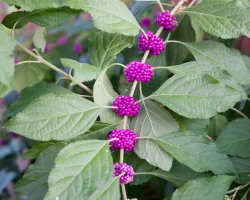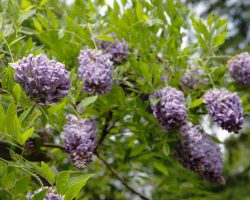If you’ve seen a native winterberry shrub in the winter, you will not forget it. Winterberry covers itself in bright red berries, a treasured food source for 48 species of birds during the coldest winter months. The berries look especially striking because winterberry is deciduous—meaning it loses its leaves in the winter—putting the spotlight on its berry-filled stems.
Do you dream of birdwatching from the comfort of your home in the winter? Do you love seeing bright things during the cold months? Winterberry is the shrub for you. Find planting tips below.

What are the benefits of planting native winterberries?
Native winterberries (Ilex verticillata) are a stunning addition to any garden, offering beauty and function all year long. Here’s why they’re a great choice:
- Year-Round Beauty: Bright red berries shine in fall and winter, adding vibrant color when most other plants are dormant. In spring and summer, glossy green leaves and small white flowers provide a fresh, vibrant look.
- Bird Magnet: Birds like robins, eastern bluebirds, and eastern cardinals rely on the berries for food during winter. Their flowers attract pollinators in warmer months, helping wildlife all year long.
- Super adaptable: Winterberries thrive in wet areas, like near ponds or streams, but also adapt well to regular garden conditions. Once established, they require little care, making them ideal for busy gardeners.
- Winter Landscaping Beauty: Winterberries drop their leaves in the winter, putting the spotlight on the bright berries. Perfect as a hedge, in a mixed border, or as a stand-alone feature, their bright berries create a striking visual focal point in winter, even on the dreariest days.
By planting winterberries, you add a resilient, beautiful shrub that brings seasonal interest, supports wildlife, and thrives with minimal effort.
Where is winterberry native?
Winterberry (Ilex verticillata) is native to a wide swath of North America. Anyone from Maine west to Minnesota, south to the Florida panhandle, and even as far west as eastern Texas and Louisiana can plant winterberry.
Winterberries: A lifeline for birds in winter
While many birds prefer other berries in the fall, like the antioxidant-rich berries of arrowwood viburnum or Eastern flowering dogwood, winterberries play an important role later in the season.
Migratory birds often leave before winter sets in, but birds that stay behind, like northern cardinals and some Eastern bluebirds, rely on winterberries when other food sources are long gone. Their bright red berries persist through the cold months, providing a much-needed backup food source during the most challenging part of winter.
If you want to help winter birds thrive, planting winterberries is a beautiful and easy way to support them through the colder months.

How to plant winterberry
Winterberry is a low-maintenance plant that is easy to grow. You can plant winterberry in a wide range of sun, from full sun to part shade.
Water needs depend on the type of Winterberry. Native winterberry grows in nature in swamps and wet places, but winterberry cultivars offer options for drier environments.
A few challenges to consider with winterberry
There are a few issues to consider when planting winterberry.
You’ll need male + female plants for berries
First, native winterberries are dioecious, which means that you need both male and female plants for the female plants to produce berries.
- Both male and female plants need to be at most 40 feet apart.
- Be sure to plant at least one male plant for every five female plants.
If you’re wondering whether it’s male or female, visit a trusted local native nursery when purchasing winterberry. The staff will help!
Winterberries like acidic soil
Finally, native winterberries like acidic soil. Other acidic-loving native plants include native rhododendrons and native azaleas, highbush blueberries, false blue indigo, and mountain laurels.
FAQs
Are the berries on winterberries poisonous?
YES, winterberry berries are toxic if ingested. This shrub may not be a good choice if you have pets or small children who might try to eat the berries.
What does acidic soil mean?
Acidic soil has a lower pH level, meaning it’s on the “cooler” side of a scale that measures how acidic or alkaline soil is. pH is measured from 0 to 14, with 7 being neutral. Acidic soil has a pH below 7, typically in the 5.0 to 6.5 range for plants like rhododendrons, azaleas, and blueberries.
Think of soil pH like a thermostat in your garden. Some plants thrive in “cooler” acidic soil, while others prefer “warmer” alkaline soil. Knowing your soil’s pH helps you choose the right plants for your yard.
To find out if your soil is acidic, you can easily test it with a pH kit from a garden center. If it’s in the “cool range,” you’re ready to grow acid-loving plants. You can also send a soil sample using your local university’s Cooperative Extension office.
Now that I’m thinking about it, what does pH mean?
pH stands for ‘potential of hydrogen,’ which measures the concentration of hydrogen ions in soil, water, or other substances. pH is important in plants because it affects how plants absorb nutrients.
How to plant a new winterberry bush
When planting winterberry, dig a hole that is twice the size of the root ball. Mix some compost or other organic matter into the soil to help with drainage and add nutrients. Place the plant in the hole and backfill it with the new compost-mixed soil, being careful not to cover the crown of the plant. Water thoroughly after planting and during dry spells in the first year, to help get the plant established.
If you are planting more than one winterberry, plant them at least 5-6 feet apart so they each have room to grow.
What pairs well with native winterberry?
Winterberries look great alongside other native plants that also thrive in acidic soil, such as mountain laurel and native rhododendrons. Some inspiration includes:

Pairs well with
To wrap up this love letter, winterberries are beautiful and low-maintenance native shrubs that add a pop of color (and birdwatching opportunities) during the winter months. Winterberries are excellent four-season choices for anyone in the Northeast, Mid-Atlantic, Midwest, or South. Planting native shrubs like winterberry saves a ton of water, time, and money—especially compared to lawns or non-native plants. Head over to our Beginner’s Guide to Native Dogwoods, or our Beginner’s Guide to Native Azaleas to find some more pairing inspo. Happy planting!
Sources
- Nelson, Gil. Best Native Plants for Southern Gardens: A Handbook for Gardeners, Homeowners, and Professionals, (2010). 333–334.
- USDA, Common Winterberry Fact Sheet (PDF).
- Jessica A. Bolser, Rebecca R. Alan, Adam D. Smith, Liya Li, Navindra P. Seeram, Scott R. McWilliams “Birds Select Fruits with More Anthocyanins and Phenolic Compounds During Autumn Migration,” The Wilson Journal of Ornithology, 125(1), 97-108, (1 March 2013). https://doi.org/10.1676/12-057.1.
- Gervais, Jennifer A., and Nathaniel T. Wheelwright. “Winter Fruit Removal in Four Plant Species in Maine.” Maine Naturalist 2, no. 1 (1994): 15–24. https://doi.org/10.2307/3858155.
- Penn State Extension. “Managing Habitat for Eastern Bluebirds,” n.d. https://extension.psu.edu/managing-habitat-for-eastern-bluebirds.
- American Bird Conservancy, “Northern Cardinal – American Bird Conservancy,” September 7, 2021, https://abcbirds.org/bird/northern-cardinal/.
- Huixin Lu, Peng Zhou, Fei Li, Yanjie Wang, Jiaying Gu, Ying Wang, Shubin Sun, Min Zhang, Xiaowen Wang, Trichoderma guizhouense NJAU4742 augments morphophysiological responses, nutrient availability and photosynthetic efficacy of ornamental Ilex verticillata, Tree Physiology, Volume 44, Issue 4, April 2024, tpae033, https://doi.org/10.1093/treephys/tpae033
What if your feed was actually good for your mental health?
Give your algorithm a breath of fresh air and follow us.
























